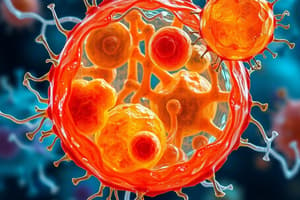Podcast
Questions and Answers
What is the size range of eukaryotic cells?
What is the size range of eukaryotic cells?
- 10-100 µm (correct)
- 1-10 µm
- 100-500 µm
- 500-1000 µm
What are the four main classifications of eukaryotic cells?
What are the four main classifications of eukaryotic cells?
Protista, Fungi, Plantae, Animalia
Eukaryotic cells are simpler in structure compared to prokaryotic cells.
Eukaryotic cells are simpler in structure compared to prokaryotic cells.
False (B)
The cell membrane is composed of two sheets of __________.
The cell membrane is composed of two sheets of __________.
Which component of phospholipids is hydrophobic?
Which component of phospholipids is hydrophobic?
The cell membrane is permeable to all types of molecules.
The cell membrane is permeable to all types of molecules.
The cell membrane regulates the passage of molecules using which property?
The cell membrane regulates the passage of molecules using which property?
What is the term used to describe the composition of the cell membrane that includes proteins and lipids?
What is the term used to describe the composition of the cell membrane that includes proteins and lipids?
What are the main functions of membrane proteins?
What are the main functions of membrane proteins?
Flashcards are hidden until you start studying
Study Notes
Eukaryotic Cells
- Eukaryotic cells are more complex and larger than prokaryotic cells, typically ranging from 10-100 µm.
- Cells are highly compartmentalized into organelles, facilitating specialized functions.
- Major classifications include Protista, Fungi, Plantae, and Animalia, each with unique characteristics but sharing common features.
Cell Structures
- Cell structures fall into five main categories:
- Structures for protection
- Genetic control organelles
- Manufacturing, storing, distributing, and breakdown organelles
- Energy processing organelles
- Organelles for structural support, movement, and intercellular communication
Structures for Protection
Cell Membrane
-
Acts as a barrier to segregate the cell's internal environment from its external surroundings.
-
Regulates the movement of molecules in and out of the cell, enabling selective permeability.
-
Comprised of a phospholipid bilayer, made of two sheets of phospholipids.
-
Each phospholipid has:
- A hydrophilic polar head (phosphate group and glycerol)
- Two hydrophobic non-polar fatty acid tails
-
The arrangement results in:
- Hydrophobic tails clustering away from the environment, forming the inner layer of the membrane.
- Hydrophilic heads orienting towards the exterior and interior of the cell.
-
Selective permeability restricts non-polar molecules like glucose from freely entering or exiting the cell.
Membrane Proteins
- Cell membranes contain randomly distributed proteins and other molecules, contributing to the membrane's fluid characteristics.
- The term "Fluid Mosaic" describes this structure, highlighting the dynamic nature of the phospholipid bilayer and the embedded proteins, as coined by researchers Nicolson and Singer.
Studying That Suits You
Use AI to generate personalized quizzes and flashcards to suit your learning preferences.




